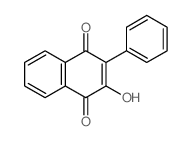
| 规格 | 价格 | 库存 | 数量 |
|---|---|---|---|
| 1mg |
|
||
| 5mg |
|
||
| 10mg |
|
||
| 25mg |
|
||
| 50mg |
|
||
| 100mg |
|
||
| 250mg |
|
||
| 500mg |
|
||
| Other Sizes |
|
| 靶点 |
Mitochondrial electron transport
|
|---|---|
| 体外研究 (In Vitro) |
抗疟药 14(化合物 N3)(0-400 μM,48 小时)对人体细胞具有最小的细胞毒性作用,并抑制恶性疟原虫 [1]。抗疟药物 14 抑制恶性疟原虫的线粒体膜电位,IC50ΔΨmit 为 16 μM [1]。在体外评估一系列3-烷基-2-羟基-1,4-萘醌(N1-N5)的抗疟疾活性,评估培养48小时后的寄生虫血症。使用MTT测定法评估HEK293T细胞中的潜在细胞毒性。使用荧光染料Mitrotracker Red CMXROS[1]测量疟原虫线粒体膜电位的变化。
|
| 酶活实验 |
线粒体膜电位(ΨΔmit)的变化[1]
如前所述,使用5μM Mitrotracker红CMXROS测定寄生虫线粒体膜电位损失(ΨΔmit)[18]。培养物与染料在37°C下孵育30分钟,然后与10倍系列稀释液(0.001-100μM)的N3和阿托伐醌孵育1小时。作为对照,使用5μM氰化物间氯苯腙(CCCP),一种消耗膜电位的原孔。通过如上所述的流式细胞术分析结果。 |
| 细胞实验 |
细胞毒性测定[1]
细胞类型: 恶性疟原虫和 HEK293T 测试浓度: 0.128、0.64、3.2、16、80 和 400 μM 孵育时间: 48 小时 实验结果: 对恶性疟原虫具有抑制作用,IC50 为 443 nM,细胞毒性 CC50 为 54.6 ± 0.23μM。 |
| 动物实验 |
3D7 strain parasites were cultured and synchronized as described previously. Briefly, parasites were routinely maintained in A+ human erythrocytes (1-3% parasitaemia and 2% haematocrit) in RPMI-1640 media supplemented with 0.2% sodium bicarbonate, 50 mg/L hypoxanthine and 10% type A+ human serum in 92% N2, 5% CO2 and 3% O2.
|
| 参考文献 | |
| 其他信息 |
Background: The hydroxynaphthoquinones have been extensively investigated over the past 50 years for their anti-malarial activity. One member of this class, atovaquone, is combined with proguanil in Malarone®, an important drug for the treatment and prevention of malaria.
Methods: Anti-malarial activity was assessed in vitro for a series of 3-alkyl-2-hydroxy-1,4-naphthoquinones (N1-N5) evaluating the parasitaemia after 48 hours of incubation. Potential cytotoxicity in HEK293T cells was assessed using the MTT assay. Changes in mitochondrial membrane potential of Plasmodium were measured using the fluorescent dye Mitrotracker Red CMXROS. Results: Four compounds demonstrated IC50s in the mid-micromolar range, and the most active compound, N3, had an IC50 of 443 nM. N3 disrupted mitochondrial membrane potential, and after 1 hour presented an IC50ΔΨmit of 16 μM. In an in vitro cytotoxicity assay using HEK 293T cells N3 demonstrated no cytotoxicity at concentrations up to 16 μM. Conclusions: N3 was a potent inhibitor of mitochondrial electron transport, had nanomolar activity against cultured Plasmodium falciparum and showed minimal cytotoxicity. N3 may serve as a starting point for the design of new hydroxynaphthoquinone anti-malarials.[1] |
| 分子式 |
C16H10O3
|
|---|---|
| 分子量 |
250.249
|
| 精确质量 |
250.063
|
| CAS号 |
1150-59-0
|
| PubChem CID |
265893
|
| 外观&性状 |
Yellow to brown solid
|
| 密度 |
1.392g/cm3
|
| 沸点 |
445.3ºC at 760 mmHg
|
| 闪点 |
237.2ºC
|
| 蒸汽压 |
1.04E-08mmHg at 25°C
|
| 折射率 |
1.693
|
| LogP |
3.034
|
| tPSA |
54.37
|
| 氢键供体(HBD)数目 |
1
|
| 氢键受体(HBA)数目 |
3
|
| 可旋转键数目(RBC) |
1
|
| 重原子数目 |
19
|
| 分子复杂度/Complexity |
429
|
| 定义原子立体中心数目 |
0
|
| SMILES |
C1=CC=C(C2C(=O)C(=O)C3=CC=CC=C3C=2O)C=C1
|
| InChi Key |
HCKUADBGJIXWTR-UHFFFAOYSA-N
|
| InChi Code |
InChI=1S/C16H10O3/c17-14-11-8-4-5-9-12(11)15(18)16(19)13(14)10-6-2-1-3-7-10/h1-9,17H
|
| 化学名 |
2-hydroxy-3-phenylnaphthalene-1,4-dione
|
| 别名 |
NSC102533; NSC 102533; 2-Hydroxy-3-phenyl-1,4-naphthoquinone; 4-hydroxy-3-phenylnaphthalene-1,2-dione; 2-hydroxy-3-phenylnaphthalene-1,4-dione; NSC 102533; 1,4-Naphthalenedione, 2-hydroxy-3-phenyl-; Antimalarial agent 14; 4-hydroxy-3-phenyl-naphthalene-1,2-dione; NSC-102533
|
| HS Tariff Code |
2934.99.9001
|
| 存储方式 |
Powder -20°C 3 years 4°C 2 years In solvent -80°C 6 months -20°C 1 month |
| 运输条件 |
Room temperature (This product is stable at ambient temperature for a few days during ordinary shipping and time spent in Customs)
|
| 溶解度 (体外实验) |
DMSO: ~125 mg/mL (499.5 mM)
|
|---|---|
| 溶解度 (体内实验) |
注意: 如下所列的是一些常用的体内动物实验溶解配方,主要用于溶解难溶或不溶于水的产品(水溶度<1 mg/mL)。 建议您先取少量样品进行尝试,如该配方可行,再根据实验需求增加样品量。
注射用配方
注射用配方1: DMSO : Tween 80: Saline = 10 : 5 : 85 (如: 100 μL DMSO → 50 μL Tween 80 → 850 μL Saline)(IP/IV/IM/SC等) *生理盐水/Saline的制备:将0.9g氯化钠/NaCl溶解在100 mL ddH ₂ O中,得到澄清溶液。 注射用配方 2: DMSO : PEG300 :Tween 80 : Saline = 10 : 40 : 5 : 45 (如: 100 μL DMSO → 400 μL PEG300 → 50 μL Tween 80 → 450 μL Saline) 注射用配方 3: DMSO : Corn oil = 10 : 90 (如: 100 μL DMSO → 900 μL Corn oil) 示例: 以注射用配方 3 (DMSO : Corn oil = 10 : 90) 为例说明, 如果要配制 1 mL 2.5 mg/mL的工作液, 您可以取 100 μL 25 mg/mL 澄清的 DMSO 储备液,加到 900 μL Corn oil/玉米油中, 混合均匀。 View More
注射用配方 4: DMSO : 20% SBE-β-CD in Saline = 10 : 90 [如:100 μL DMSO → 900 μL (20% SBE-β-CD in Saline)] 口服配方
口服配方 1: 悬浮于0.5% CMC Na (羧甲基纤维素钠) 口服配方 2: 悬浮于0.5% Carboxymethyl cellulose (羧甲基纤维素) 示例: 以口服配方 1 (悬浮于 0.5% CMC Na)为例说明, 如果要配制 100 mL 2.5 mg/mL 的工作液, 您可以先取0.5g CMC Na并将其溶解于100mL ddH2O中,得到0.5%CMC-Na澄清溶液;然后将250 mg待测化合物加到100 mL前述 0.5%CMC Na溶液中,得到悬浮液。 View More
口服配方 3: 溶解于 PEG400 (聚乙二醇400) 请根据您的实验动物和给药方式选择适当的溶解配方/方案: 1、请先配制澄清的储备液(如:用DMSO配置50 或 100 mg/mL母液(储备液)); 2、取适量母液,按从左到右的顺序依次添加助溶剂,澄清后再加入下一助溶剂。以 下列配方为例说明 (注意此配方只用于说明,并不一定代表此产品 的实际溶解配方): 10% DMSO → 40% PEG300 → 5% Tween-80 → 45% ddH2O (或 saline); 假设最终工作液的体积为 1 mL, 浓度为5 mg/mL: 取 100 μL 50 mg/mL 的澄清 DMSO 储备液加到 400 μL PEG300 中,混合均匀/澄清;向上述体系中加入50 μL Tween-80,混合均匀/澄清;然后继续加入450 μL ddH2O (或 saline)定容至 1 mL; 3、溶剂前显示的百分比是指该溶剂在最终溶液/工作液中的体积所占比例; 4、 如产品在配制过程中出现沉淀/析出,可通过加热(≤50℃)或超声的方式助溶; 5、为保证最佳实验结果,工作液请现配现用! 6、如不确定怎么将母液配置成体内动物实验的工作液,请查看说明书或联系我们; 7、 以上所有助溶剂都可在 Invivochem.cn网站购买。 |
| 制备储备液 | 1 mg | 5 mg | 10 mg | |
| 1 mM | 3.9960 mL | 19.9800 mL | 39.9600 mL | |
| 5 mM | 0.7992 mL | 3.9960 mL | 7.9920 mL | |
| 10 mM | 0.3996 mL | 1.9980 mL | 3.9960 mL |
1、根据实验需要选择合适的溶剂配制储备液 (母液):对于大多数产品,InvivoChem推荐用DMSO配置母液 (比如:5、10、20mM或者10、20、50 mg/mL浓度),个别水溶性高的产品可直接溶于水。产品在DMSO 、水或其他溶剂中的具体溶解度详见上”溶解度 (体外)”部分;
2、如果您找不到您想要的溶解度信息,或者很难将产品溶解在溶液中,请联系我们;
3、建议使用下列计算器进行相关计算(摩尔浓度计算器、稀释计算器、分子量计算器、重组计算器等);
4、母液配好之后,将其分装到常规用量,并储存在-20°C或-80°C,尽量减少反复冻融循环。
计算结果:
工作液浓度: mg/mL;
DMSO母液配制方法: mg 药物溶于 μL DMSO溶液(母液浓度 mg/mL)。如该浓度超过该批次药物DMSO溶解度,请首先与我们联系。
体内配方配制方法:取 μL DMSO母液,加入 μL PEG300,混匀澄清后加入μL Tween 80,混匀澄清后加入 μL ddH2O,混匀澄清。
(1) 请确保溶液澄清之后,再加入下一种溶剂 (助溶剂) 。可利用涡旋、超声或水浴加热等方法助溶;
(2) 一定要按顺序加入溶剂 (助溶剂) 。